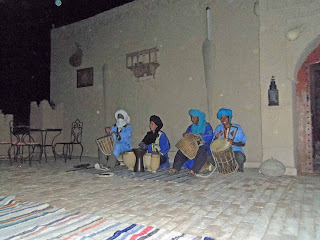
Camels have two humps, dromedaries have one hump.
Given the choice of an hour camel\dromedary ride into the
dunes to watch the sun go down then a return to our bivouac by camel or 4WD, we
opted for the return by 4WD. Having experienced the joys of bouncing around on
a camel before, (see August 2009 blog- Gobi Desert) it was the wisest choice.
The trip out into the dunes was spectacular.
Camel Riding Tips
Tip #1- Wear pants. You, not the camel!
Tips #2- Never look them in the eye. They
spit.
Tips #3- Never look them in the eye. They
have bad breath.
Tips #4- Never look them in the eye. That’s
where all the flies hang out.
Tip #5- They don’t speak English so won’t
understand what “whoa” means.
Riding a camel/ dromedary is like riding on the point of a triangle that not only moves forward, but up and down and side to side, while at the same time, it is trying to wipe the snot off its nose on your pants.
Our guides name is Mubarak, a local Berber who was up to the
task of answering our zillion questions of what life was like living in the
desert.
During the tourist season, he works full time herding tourists and camels/dromedaries
back and forth between the massive dunes and the bivouacs, auberges and hotels
that are found around the dunes. He was a
nomad but now lives in a tiny village about a half hour camel ride away from
our bivouac with his wife and two children. He can speak four languages.
Our bivouac is located on the edge of the Erg Chebbi dunes.
Local legend says that the dunes were created by God to punish Moroccans for turning away a tired traveler. It was to remind them, never to refuse a weary traveler again.
Morocco receives over 7,000,000 (2009) tourists a year so they
have their work cut out for them.
A dune is basically a mound or ridge of sand. The sand has an average diameter of .06-2.0 mm so you can only imagine how many grains of sand it would take to create a dune that is 150 m high. There are five types of dunes, crescentic, linear, star, dome and parabolic, all of which can be found in the Erg Chebbi.
They constantly grow,
change, move and disappear at the whim of the wind. We picked the highest one to climb with the
camels but stopped short as the sun was setting.
The Sahara is considered a natural desert formed by natural
processes over thousands of years. For the most part, the Sahara has natural
limiting boundaries like mountains that prevent its growth. But it is estimated
to be growing southward at rate of 5-10 kilometres a year. Though that estimate
is under dispute, its growth is not. It
is called desertification and is happening all over the world.
Walking up the last few hundred metres of the dune in bare
feet we found the consistency of sand like flour and surprisingly, despite the sun shining on
it all day, quite cool. We found out that camel rides down are quite a bit spookier than camel
rides up.
Thankfully, it was a short ride to the 4WD and an air conditioned
ride back to the bivouac where we were treated to a wonderful meal of tagine
and Moroccan salad. Mmmmm!
After dinner, the band fired up their drums and we
all went to bed with a cool Saharan beat echoing out over the dunes.













No comments:
Post a Comment